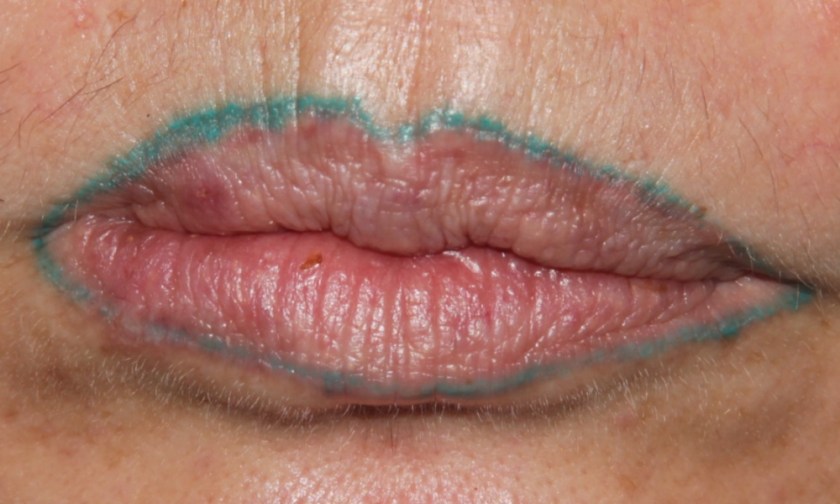A leading dermatologist has warned Australians to “think very carefully” before getting eyebrow, eyeliner or lip liner tattoos.
Dr Philip Bekhor, a specialist in procedural dermatology, sees “a couple of patients” with “incompetent cosmetic tattoos” at his Melbourne clinic each month.
Although he is able to remove most of the tattoos with a laser, Dr Bekhor says many are untreatable due to the fact that the tattooists have already tried to correct/camouflage their inking mistakes.
He explained that “over-tattooing of placement errors with white/flesh tinted pigment is an unmitigated disaster”.
“Once they put this ink in we can’t remove it because most flesh and white coloured tints have iron or titanium in them and if we hit them with laser they will turn black – a particularly unpleasant event in the case of lip liner tattoos.”
According to Dr Bekhor, the most common problems associated with cosmetic tattoos are:
Eyeliner – “The tattoo is in the wrong area or the tail is too long or too thick. In addition sometimes the ink goes too deep and migrates under the skin so it looks like the person has been crying and their eyeliner has smeared.”
Lip liner – “The placement of the tattoo is often too high. As people get older they lose lip volume and some women have their lip liner tattoo placed higher than the natural lip line to make the lip look bigger, but it makes more sense to do it on the natural lip line and use a filler to get the volume.”
Eyebrows – “These can be too harsh or not done finely enough so they look really dramatic. Women need to realise that over the years eyebrow fashions change, so if they get their eyebrows tattooed at an extreme point in the cycle they may not look that good later when trends change.”
Dr Bekhor added that he also sees cosmetic tattoos with “lots of wrong colours or colours that aren’t stable and look alright when they are first applied but then turn a funny orange”.
He said consumers should be aware that cosmetic tattoos can be safely removed with new generation picosecond lasers such as the PicoSure he uses in his clinic.
According to Cynosure, the manufacturer and distributor of PicoSure, the ultra-short pulse laser “shatters” tattoo ink “into tiny, dust link particles that are easily eliminated by the body, leaving the surrounding skin tissue uninjured”.
The laser is able to quickly and effectively remove “difficult ink colours such as blues and greens” and many previously “untreatable tattoos”.

Dr Bekhor readily acknowledges that he only sees problem tattoos which probably only account for “a very small percentage” of the tattoos performed in Australia but is nonetheless adamant he would not recommend lip tattooing to anyone.
“All of the colours that they use (the reds and orangey inks) are at risk of going black,” he said. “There is nothing that is certified safe for laser removal afterwards.
“I would use lipstick or lip filler instead – it is much safer to get lip filler than to get a permanent lip tattoo.”

Although most cosmetic tattoos treated by Dr Bekhor at Laser Dermatology are created in Australia, Dr Bekhor often treats “cosmetic” tattoos created overseas as well.
For example his client *Susan had semi-permanent lip liner tattoos regularly in Australia before deciding to get a permanent tattoo while on holiday in Tahiti.
According to *Susan, the tattoo artist told her that “a mix of blue, green and pink” would “turn to burgundy eventually”.
“I had the tattoo and it was green, and green, and green again,” she said.
“I came back from my holiday with this green thing on my face and knew it was not going to go burgundy eventually.”
*Susan sought help from a cosmetic tattooist who she hoped would “put some red over the green so it could turn burgundy-ish” but the tattooist refused to do so and instead referred her to Dr Bekhor.
She said the results after just one treatment with the PicoSure were “spectacular”.
“I was stunned – it [the green lip liner tattoo] was almost gone. It was still slightly there but the bottom was practically gone.
After four treatments “the colour was gone” and now “you can only just still see the needle marks if you look closely”.
Dr Bekhor concludes that cosmetic tattooing will always carry a risk as it is “a precise skill” and even the best tatooist can be “off their game” and make a mistake.
However he stresses most problems can “be fixed” if clients seek appropriate help.
“If ink is placed in the wrong place, it is essential that the client attend a respected medical tattoo removal clinic rather than have the cosmetic tattoo interfered with by the person who created it.”




